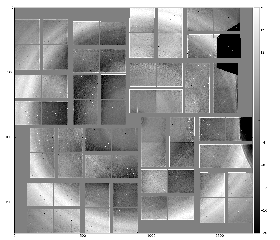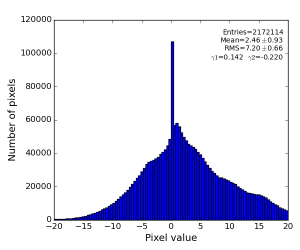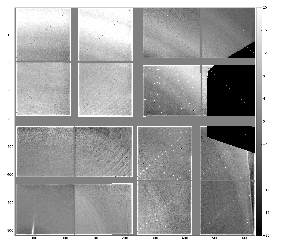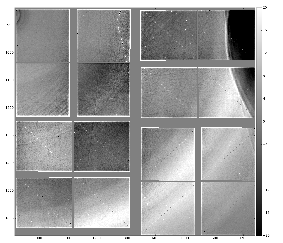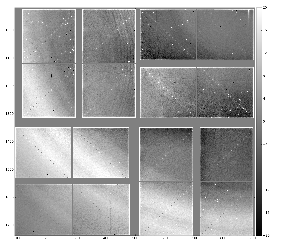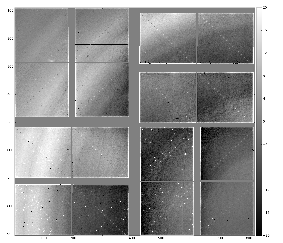This algorithm is intended to subtract background from "non-assembled" images with approximately angular-symmetric radial distribution of intensities.
For example, pure water ring background from exp=cxij4716:run=22 for single event has an angular symmetry as shown in the plot:
Class RadialBkgd resides in the package pyimgalgos.
Auto-generated documentation for class RadialBkgd
from pyimgalgos.RadialBkgd import RadialBkgd, polarization_factor rb = RadialBkgd(xarr, yarr, mask=None, radedges=None, nradbins=100, phiedges=(0,360), nphibins=32) |
See parameters' description in Auto-generated documentation for class RadialBkgd.
Input n-d arrays can be obtained through the Detector (AreaDetector) interface or directly through the class working with geometry. For example,
from PSCalib.GeometryAccess import GeometryAccess geo = GeometryAccess(fname_geo) xarr, yarr, zarr = geo.get_pixel_coords() iX, iY = geo.get_pixel_coord_indexes() mask = geo.get_pixel_mask(mbits=0377) # mask for 2x1 edges, two central columns, and unbound pixels with their neighbours ... |
To evaluate background n-d array of data is split for 2-d bins in polar coordinate frame. Total intensity and number of involved pixels are counted for each bin and converted to the average bin intensity. Then this averaged intensity is per-pixel subtracted from data n-d array.
Input per-pixel coordinates passed as numpy n-d arrays xarr and yarr are used to evaluate per-pixel radial and polar angle coordinate arrays:
rad = rb.pixel_rad() phi = rb.pixel_phi() |
Binning parameters radedges, nradbins, phiedges, nphibins are used to initialize 2-d bins using class HBins. Initialization with default binning parameters covers entire detector coordinate space.
Non-default binning, for example like
rb = RadialBkgd(X, Y, mask, nradbins=3, nphibins=8, phiedges=(-20, 240), radedges=(10000,80000)) |
defines angular pixel coordinates with correct offset relative to minimal angle,
and gives 3 bins in radial direction from 10mm to 80mm and 8 bins in angle from -20 to 240 degree:
rad = rb.pixel_rad() iseq = rb.pixel_iseq() |
Pixels masked by the n-d array passed in the parameter mask are excluded from this algorithm and are not corrected.
Averaged background intensity for default (nradbins=200, nphibins=32) and non-default (nphibins=8, nradbins=500) binning cases :
bkgd = rb.bkgd_nda(nda) |
Background subtracted data for default (nradbins=200, nphibins=32) and non-default binning cases (nradbins=500, nphibins=1), and (nradbins=500, nphibins=8, phiedges=(-20, 240)):
res = rb.subtract_bkgd(nda) |
Method for polarization correction factor:
def polarization_factor(rad, phi_deg, z) :
"""Returns per-pixel polarization factors, assuming that detector is perpendicular to Z.
"""
phi = np.deg2rad(phi_deg)
ones = np.ones_like(rad)
theta = np.arctan2(rad, z)
sxc = np.sin(theta)*np.cos(phi)
pol = 1 - sxc*sxc
return divide_protected(ones, pol, vsub_zero=0) |
Then, radial background can be estimated using ring-shaped radial bins, single bin in angle:
arr = load_txt(fname_nda) rb = RadialBkgd(X, Y, mask, nradbins=500, nphibins=1) pf = polarization_factor(rb.pixel_rad(), rb.pixel_phi(), 94e3) nda = rb.subtract_bkgd(arr * pf) * mask.flatten() |
For exp=cxij4716:run=22 z=94mm
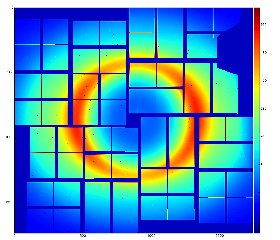
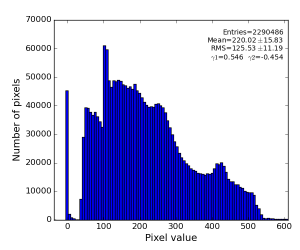


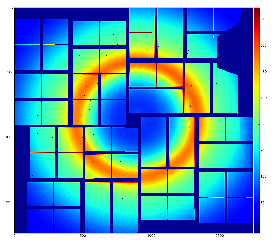
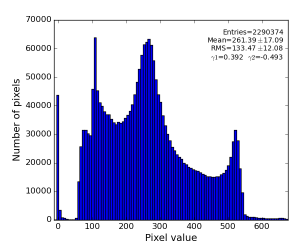
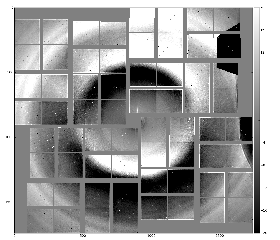

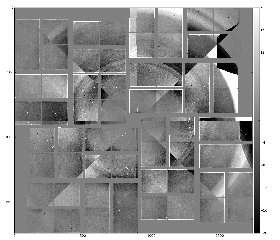
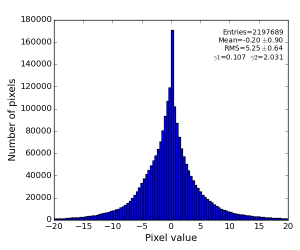
dynamically apply some geometry correction
geo = GeometryAccess(fname_geo)
geo.move_geo('CSPAD:V1', 0, 1600, 0, 0)
geo.move_geo('QUAD:V1', 2, -100, 0, 0) |
and plot again radial-background subtracted data using single angular bin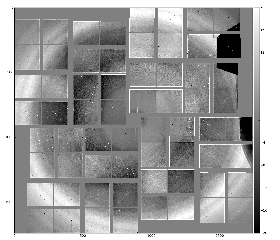
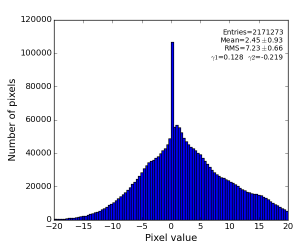
we get that "dish"-like shape disappears.
Interpolation (linear) between centers of the background bins could also help:
bkgd = rb.bkgd_nda_interpol(nda, method='linear') # method='nearest' 'cubic'
cdata = rb.subtract_interpol(nda, method='linear') |
Interpolation for entire detector and for part of the image:
Image is not as impressive as for polarization-corrected sample, but the residual intensity spread shrink down to RMS~3 ADU.

